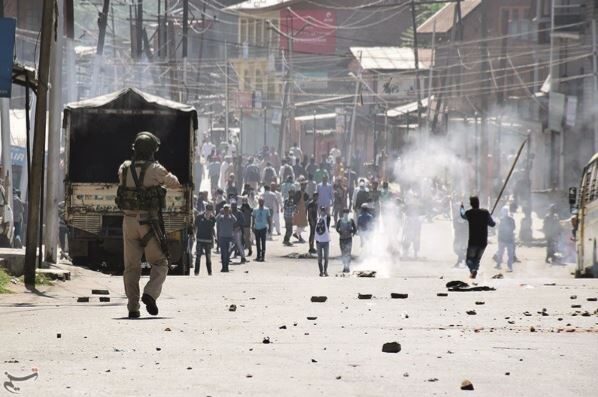Asif M Basit

Kashmir is in the news again! It always has been since the long-gone days of the British Empire; always for unrest, disturbance and conflict.
Day by day, the tragedy and suffering continues within Kashmir, without any sign of cessation.
What India and Pakistan contest each other for is a secondary question; the primary question is what the British Government had in mind when they sold it to Gulab Singh for peanuts back in the days. One could say that that too is a by-gone, so why plunge into the closed chapters of history?
But the tragedy (or the good thing rather) with history is that it is hard to shun wherever we go, floating on the tides of time. So the British saga is something we cannot avoid. Having sold Jammu and Kashmir to Gulab Singh – the so-called Maharaja – the British sat back with their feet up while communal unrest became rife in the region.
It took decades for a befitting response from the Muslims to emerge and that too on an All-India scale. The British-Indian government was taken aback, as well as the Maharaja of Kashmir. Who was behind this nationwide response of Indian Muslims?
Well, this is another interesting story. The Muslims of India had been planning to unite for the cause of the Kashmiri Muslims but had not yet been able to do so.
After many failed attempts, they decided to invite Hazrat Mirza Bashiruddin Mahmud Ahmad, Khalifatul Masih IIra to unite the Muslims at one hand. Not being a political leader, Hazrat Mirza Bashiruddin Mahmud Ahmadra reluctantly agreed only in the name of Muslim unity – something that was a dire need of the time for Muslims to progress in any field and not just the Kashmir cause.
The turn of the 1930s decade saw riots replacing diplomacy and becoming the only way of political expression. This, of course, was not the way to resolve complex issues that prevailed the region of Jammu and Kashmir. An All India Kashmiri Muslim Conference was held, soon after the bloody riots of 25 July 1931, by prominent Indian-Muslim leaders to put their heads together and find a pragmatic way forward.
Sir Muhammad Iqbal, Sir Mian Fazl-i-Hussain, the Nawab of Malerkotla, Sir Muhammad Zulfiqar Ali Khan, Khwaja Hasan Nizami of Delhi, Khan Bahadur Shaikh Rahim Bakhsh, as well as other notable Muslims leaders, were present.
Sir Iqbal nominated Hazrat Mirza Bashiruddin Mahmud Ahmadra and the members of the conference unanimously elected him as the president.
Hazrat Mirza Bashiruddin Mahmud Ahmadra was able to organise peaceful processions and conferences in various parts of India to demand the usurped rights of Kashmiri Muslims. He asked for funds to be raised and that too happened very successfully. He himself donated relatively large sums for the Kashmir cause.
It was this incredible, never-before-seen success at Muslim unity that inadvertently invited anti-Ahmadiyya sentiments to make their way; make their way into the hearts of none else but Muslims.
Blindfolded by jealousy, the potential Muslim success was seen as an Ahmadiyya victory in Kashmir and it was demanded that Hazrat Mirza Bashiruddin Mahmud Ahmadra step down as president. Happily, he accepted the demand and the committee handed over the reins to Sir Muhammad Iqbal, who had by then sold his “khudi” to the Ahrar and the “hawk” of his mind had been captured in narrow, dark and gloomy burrows of prejudice (khudi – self-respect – and hawk being two iconic metaphors of Iqbal’s nationalistic poetry).
Very able historians like Ayesha Jalal agree on the fact that it was at this point that the All India Kashmir Committee came down to shambles, never to be erected again.
We fast-forward and move to the time of the Indian partition in 1947 – Kashmir continued to remain a bone of contention between the two emerging states, with riots, unrest, conflict and war continuing to symbolise the region.
In 1949, both India and Pakistan ended up in the United Nations seeking to resolve the issue. Who was seen as the most suitable spokesperson for Pakistan on the Kashmir issue? Again, none else but an Ahmadi, Sir Zafrulla Khanra.
The solution he presented was simple and clear: Give the public of Kashmir the right to vote! He urged that the people of Kashmir were the only ones who should be deciding the fate of Kashmir. He sought for Kashmir to be demilitarised and a plebiscite be held if a just resolution was to be attained. His stance was acknowledged by the rational minded class of Indians and Pakistanis alike.
However, the advice was not paid heed to and the situation has ever since only deteriorated.
We do not intend to go into India-Pakistan diplomatic tensions here. All we want to say is that the best available advice on Kashmir has always come from the Ahmadiyya Muslim Jamaat.
The present Imam of the Ahmadiyya Jamaat holds high the flag of international peace and harmony. Is it still not time to pay heed?

